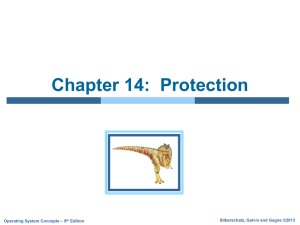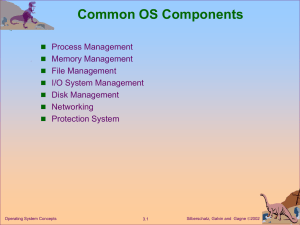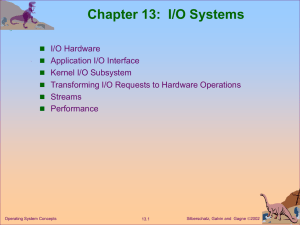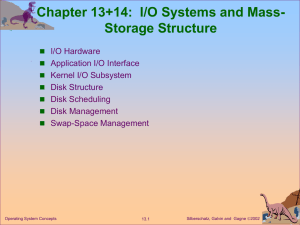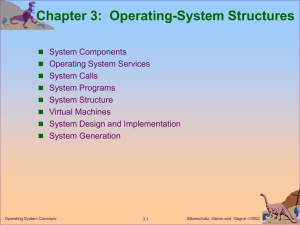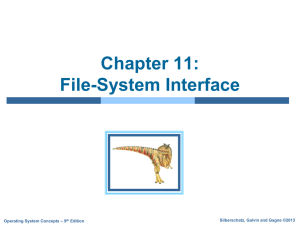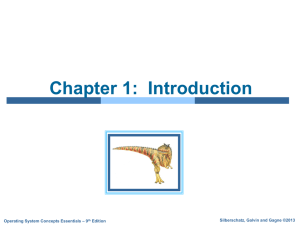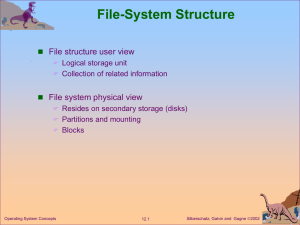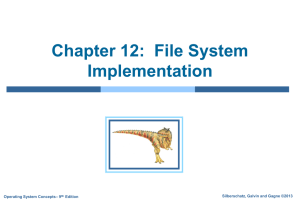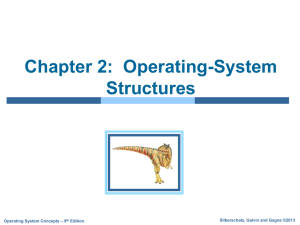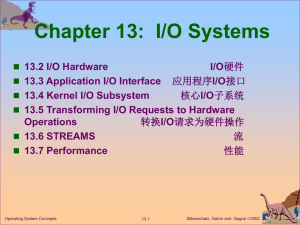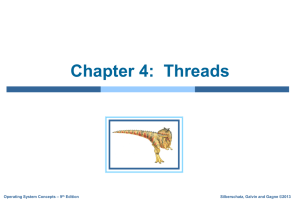ppt
advertisement
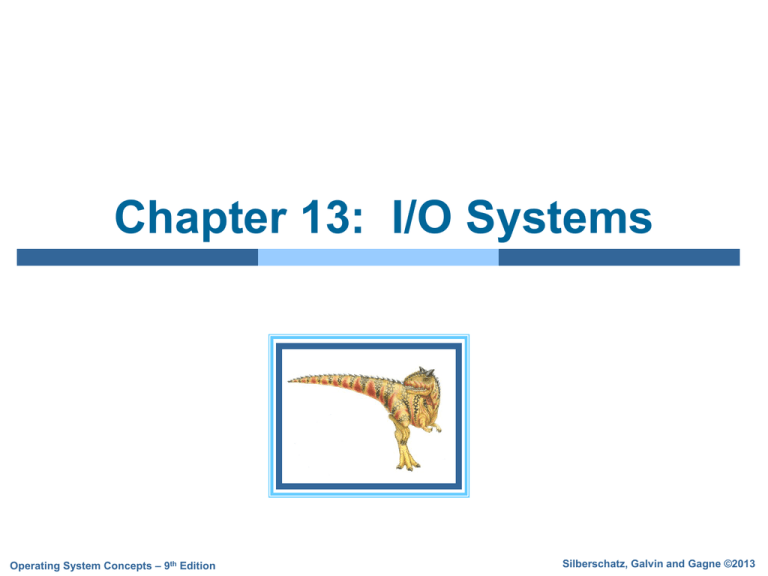
Chapter 13: I/O Systems
Operating System Concepts – 9th Edition
Silberschatz, Galvin and Gagne ©2013
Chapter 13: I/O Systems
Overview
I/O Hardware
Application I/O Interface
Kernel I/O Subsystem
Transforming I/O Requests to Hardware Operations
STREAMS
Performance
Operating System Concepts – 9th Edition
13.2
Silberschatz, Galvin and Gagne ©2013
Objectives
Explore the structure of an operating system’s I/O subsystem
Discuss the principles of I/O hardware and its complexity
Provide details of the performance aspects of I/O hardware
and software
Operating System Concepts – 9th Edition
13.3
Silberschatz, Galvin and Gagne ©2013
Overview
I/O management is a major component of operating system
design and operation
Important aspect of computer operation
I/O devices vary greatly
Various methods to control them
Performance management
New types of devices frequent
Ports, busses, device controllers connect to various devices
Device drivers encapsulate device details
Present uniform device-access interface to I/O subsystem
Operating System Concepts – 9th Edition
13.4
Silberschatz, Galvin and Gagne ©2013
I/O Hardware
Incredible variety of I/O devices
Storage
Transmission
Human-interface
Common concepts – signals from I/O devices interface with computer
Port – connection point for device
Bus - daisy chain or shared direct access
PCI bus common in PCs and servers, PCI Express (PCIe)
expansion bus connects relatively slow devices
Controller (host adapter) – electronics that operate port, bus, device
Sometimes integrated
Sometimes separate circuit board (host adapter)
Contains processor, microcode, private memory, bus controller, etc
–
Some talk to per-device controller with bus controller, microcode,
memory, etc
Operating System Concepts – 9th Edition
13.5
Silberschatz, Galvin and Gagne ©2013
A Typical PC Bus Structure
Operating System Concepts – 9th Edition
13.6
Silberschatz, Galvin and Gagne ©2013
I/O Hardware (Cont.)
I/O instructions control devices
Devices usually have registers where device driver places
commands, addresses, and data to write, or read data from
registers after command execution
Data-in register, data-out register, status register, control
register
Typically 1-4 bytes, or FIFO buffer
Devices have addresses, used by
Direct I/O instructions
Memory-mapped I/O
Device data and command registers mapped to
processor address space
Especially for large address spaces (graphics)
Operating System Concepts – 9th Edition
13.7
Silberschatz, Galvin and Gagne ©2013
Device I/O Port Locations on PCs (partial)
Operating System Concepts – 9th Edition
13.8
Silberschatz, Galvin and Gagne ©2013
Polling
For each byte of I/O
1.
Read busy bit from status register until 0
2.
Host sets read or write bit and if write copies data into data-out
register
3.
Host sets command-ready bit
4.
Controller sets busy bit, executes transfer
5.
Controller clears busy bit, error bit, command-ready bit when
transfer done
Step 1 is busy-wait cycle to wait for I/O from device
Reasonable if device is fast
But inefficient if device slow
CPU switches to other tasks?
But if miss a cycle data overwritten / lost
Operating System Concepts – 9th Edition
13.9
Silberschatz, Galvin and Gagne ©2013
Interrupts
Polling can happen in 3 instruction cycles
Read status, logical-and to extract status bit, branch if not zero
How to be more efficient if non-zero infrequently?
CPU Interrupt-request line triggered by I/O device
Checked by processor after each instruction
Interrupt handler receives interrupts
Maskable to ignore or delay some interrupts
Interrupt vector to dispatch interrupt to correct handler
Context switch at start and end
Based on priority
Some nonmaskable
Interrupt chaining if more than one device at same interrupt
number
Operating System Concepts – 9th Edition
13.10
Silberschatz, Galvin and Gagne ©2013
Interrupt-Driven I/O Cycle
Operating System Concepts – 9th Edition
13.11
Silberschatz, Galvin and Gagne ©2013
Intel Pentium Processor Event-Vector Table
Operating System Concepts – 9th Edition
13.12
Silberschatz, Galvin and Gagne ©2013
Interrupts (Cont.)
Interrupt mechanism also used for exceptions
Terminate process, crash system due to hardware error
Page fault executes when memory access error
System call executes via trap to trigger kernel to execute
request
Multi-CPU systems can process interrupts concurrently
If operating system designed to handle it
Used for time-sensitive processing, frequent, must be fast
Operating System Concepts – 9th Edition
13.13
Silberschatz, Galvin and Gagne ©2013
Direct Memory Access
Used to avoid programmed I/O (one byte at a time) for large data
movement
Requires DMA controller
Bypasses CPU to transfer data directly between I/O device and
memory
OS writes DMA command block into memory
Source and destination addresses
Read or write mode
Count of bytes
Writes location of command block to DMA controller
Bus mastering of DMA controller – grabs bus from CPU
Cycle stealing from CPU but still much more efficient
When done, interrupts to signal completion
Version that is aware of virtual addresses can be even more efficient -
DVMA
Operating System Concepts – 9th Edition
13.14
Silberschatz, Galvin and Gagne ©2013
Six Step Process to Perform DMA Transfer
Operating System Concepts – 9th Edition
13.15
Silberschatz, Galvin and Gagne ©2013
Application I/O Interface
I/O system calls encapsulate device behaviors in generic classes
Device-driver layer hides differences among I/O controllers from kernel
New devices talking already-implemented protocols need no extra
work
Each OS has its own I/O subsystem structures and device driver
frameworks
Devices vary in many dimensions
Character-stream or block
Sequential or random-access
Synchronous or asynchronous (or both)
Sharable or dedicated
Speed of operation
read-write, read only, or write only
Operating System Concepts – 9th Edition
13.16
Silberschatz, Galvin and Gagne ©2013
A Kernel I/O Structure
Operating System Concepts – 9th Edition
13.17
Silberschatz, Galvin and Gagne ©2013
Characteristics of I/O Devices
Operating System Concepts – 9th Edition
13.18
Silberschatz, Galvin and Gagne ©2013
Characteristics of I/O Devices (Cont.)
Subtleties of devices handled by device drivers
Broadly I/O devices can be grouped by the OS into
Block I/O
Character I/O (Stream)
Memory-mapped file access
Network sockets
For direct manipulation of I/O device specific characteristics,
usually an escape / back door
Unix ioctl() call to send arbitrary bits to a device control
register and data to device data register
Operating System Concepts – 9th Edition
13.19
Silberschatz, Galvin and Gagne ©2013
Block and Character Devices
Block devices include disk drives
Commands include read, write, seek
Raw I/O, direct I/O, or file-system access
Memory-mapped file access possible
File mapped to virtual memory and clusters brought via
demand paging
DMA
Character devices include keyboards, mice, serial ports
Commands include get(), put()
Libraries layered on top allow line editing
Operating System Concepts – 9th Edition
13.20
Silberschatz, Galvin and Gagne ©2013
Network Devices
Varying enough from block and character to have own
interface
Linux, Unix, Windows and many others include socket
interface
Separates network protocol from network operation
Includes select() functionality
Approaches vary widely (pipes, FIFOs, streams, queues,
mailboxes)
Operating System Concepts – 9th Edition
13.21
Silberschatz, Galvin and Gagne ©2013
Clocks and Timers
Provide current time, elapsed time, timer
Normal resolution about 1/60 second
Some systems provide higher-resolution timers
Programmable interval timer used for timings, periodic
interrupts
ioctl() (on UNIX) covers odd aspects of I/O such as
clocks and timers
Operating System Concepts – 9th Edition
13.22
Silberschatz, Galvin and Gagne ©2013
Nonblocking and Asynchronous I/O
Blocking - process suspended until I/O completed
Easy to use and understand
Insufficient for some needs
Nonblocking - I/O call returns as much as available
User interface, data copy (buffered I/O)
Implemented via multi-threading
Returns quickly with count of bytes read or written
select() to find if data ready then read() or write()
to transfer
Asynchronous - process runs while I/O executes
Difficult to use
I/O subsystem signals process when I/O completed
Operating System Concepts – 9th Edition
13.23
Silberschatz, Galvin and Gagne ©2013
Two I/O Methods
Synchronous
Operating System Concepts – 9th Edition
Asynchronous
13.24
Silberschatz, Galvin and Gagne ©2013
Vectored I/O
Vectored I/O allows one system call to perform multiple I/O
operations
For example, Unix readve() accepts a vector of multiple
buffers to read into or write from
This scatter-gather method better than multiple individual I/O
calls
Decreases context switching and system call overhead
Some versions provide atomicity
Avoid for example worry about multiple threads
changing data as reads / writes occurring
Operating System Concepts – 9th Edition
13.25
Silberschatz, Galvin and Gagne ©2013
Kernel I/O Subsystem
Scheduling
Some I/O request ordering via per-device queue
Some OSs try fairness
Some implement Quality Of Service (i.e. IPQOS)
Buffering - store data in memory while transferring between devices
To cope with device speed mismatch
To cope with device transfer size mismatch
To maintain “copy semantics”
Double buffering – two copies of the data
Kernel and user
Varying sizes
Full / being processed and not-full / being used
Copy-on-write can be used for efficiency in some cases
Operating System Concepts – 9th Edition
13.26
Silberschatz, Galvin and Gagne ©2013
Device-status Table
Operating System Concepts – 9th Edition
13.27
Silberschatz, Galvin and Gagne ©2013
Sun Enterprise 6000 Device-Transfer Rates
Operating System Concepts – 9th Edition
13.28
Silberschatz, Galvin and Gagne ©2013
Kernel I/O Subsystem
Caching - faster device holding copy of data
Always just a copy
Key to performance
Sometimes combined with buffering
Spooling - hold output for a device
If device can serve only one request at a time
i.e., Printing
Device reservation - provides exclusive access to a device
System calls for allocation and de-allocation
Watch out for deadlock
Operating System Concepts – 9th Edition
13.29
Silberschatz, Galvin and Gagne ©2013
Error Handling
OS can recover from disk read, device unavailable, transient
write failures
Retry a read or write, for example
Some systems more advanced – Solaris FMA, AIX
Track error frequencies, stop using device with
increasing frequency of retry-able errors
Most return an error number or code when I/O request fails
System error logs hold problem reports
Operating System Concepts – 9th Edition
13.30
Silberschatz, Galvin and Gagne ©2013
I/O Protection
User process may accidentally or purposefully attempt to
disrupt normal operation via illegal I/O instructions
All I/O instructions defined to be privileged
I/O must be performed via system calls
Memory-mapped and I/O port memory locations must
be protected too
Operating System Concepts – 9th Edition
13.31
Silberschatz, Galvin and Gagne ©2013
Use of a System Call to Perform I/O
Operating System Concepts – 9th Edition
13.32
Silberschatz, Galvin and Gagne ©2013
Kernel Data Structures
Kernel keeps state info for I/O components, including open file
tables, network connections, character device state
Many, many complex data structures to track buffers, memory
allocation, “dirty” blocks
Some use object-oriented methods and message passing to
implement I/O
Windows uses message passing
Message with I/O information passed from user mode
into kernel
Message modified as it flows through to device driver
and back to process
Pros / cons?
Operating System Concepts – 9th Edition
13.33
Silberschatz, Galvin and Gagne ©2013
UNIX I/O Kernel Structure
Operating System Concepts – 9th Edition
13.34
Silberschatz, Galvin and Gagne ©2013
Power Management
Not strictly domain of I/O, but much is I/O related
Computers and devices use electricity, generate heat, frequently
require cooling
OSes can help manage and improve use
Cloud computing environments move virtual machines
between servers
Can end up evacuating whole systems and shutting them
down
Mobile computing has power management as first class OS
aspect
Operating System Concepts – 9th Edition
13.35
Silberschatz, Galvin and Gagne ©2013
Power Management (Cont.)
For example, Android implements
Component-level power management
Understands relationship between components
Build device tree representing physical device topology
System bus -> I/O subsystem -> {flash, USB storage}
Device driver tracks state of device, whether in use
Unused component – turn it off
All devices in tree branch unused – turn off branch
Wake locks – like other locks but prevent sleep of device when lock
is held
Power collapse – put a device into very deep sleep
Marginal power use
Only awake enough to respond to external stimuli (button
press, incoming call)
Operating System Concepts – 9th Edition
13.36
Silberschatz, Galvin and Gagne ©2013
I/O Requests to Hardware Operations
Consider reading a file from disk for a process:
Determine device holding file
Translate name to device representation
Physically read data from disk into buffer
Make data available to requesting process
Return control to process
Operating System Concepts – 9th Edition
13.37
Silberschatz, Galvin and Gagne ©2013
Life Cycle of An I/O Request
Operating System Concepts – 9th Edition
13.38
Silberschatz, Galvin and Gagne ©2013
STREAMS
STREAM – a full-duplex communication channel between a
user-level process and a device in Unix System V and beyond
A STREAM consists of:
STREAM head interfaces with the user process
driver end interfaces with the device
zero or more STREAM modules between them
Each module contains a read queue and a write queue
Message passing is used to communicate between queues
Flow control option to indicate available or busy
Asynchronous internally, synchronous where user process
communicates with stream head
Operating System Concepts – 9th Edition
13.39
Silberschatz, Galvin and Gagne ©2013
The STREAMS Structure
Operating System Concepts – 9th Edition
13.40
Silberschatz, Galvin and Gagne ©2013
Performance
I/O a major factor in system performance:
Demands CPU to execute device driver, kernel I/O
code
Context switches due to interrupts
Data copying
Network traffic especially stressful
Operating System Concepts – 9th Edition
13.41
Silberschatz, Galvin and Gagne ©2013
Intercomputer Communications
Operating System Concepts – 9th Edition
13.42
Silberschatz, Galvin and Gagne ©2013
Improving Performance
Reduce number of context switches
Reduce data copying
Reduce interrupts by using large transfers, smart controllers,
polling
Use DMA
Use smarter hardware devices
Balance CPU, memory, bus, and I/O performance for highest
throughput
Move user-mode processes / daemons to kernel threads
Operating System Concepts – 9th Edition
13.43
Silberschatz, Galvin and Gagne ©2013
Device-Functionality Progression
Operating System Concepts – 9th Edition
13.44
Silberschatz, Galvin and Gagne ©2013
End of Chapter 13
Operating System Concepts – 9th Edition
Silberschatz, Galvin and Gagne ©2013
